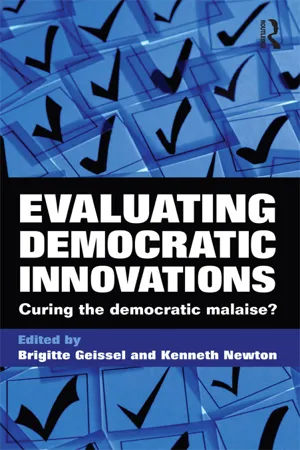
Evaluating Democratic Innovations
Curing the Democratic Malaise?
- 222 pages
- English
- ePUB (mobile friendly)
- Available on iOS & Android
Evaluating Democratic Innovations
Curing the Democratic Malaise?
About This Book
In the face of increasing political disenchantment, many Western governments have experimented, with innovations which aim to enhance the working and quality of democracy as well as increasing citizens' political awareness and understanding of political matters.
This text is the most comprehensive account of these various democratic innovations. Written by an outstanding team of international experts it examines the theories behind these democratic innovations, how they have worked in practice and evaluates their success or failure. It explains experiments with new forms of democratic engagement such as:
-
- Direct Democracy
-
- Deliberative Democracy
-
- Co-Governance
-
- E-Democracy
Drawing on a wide variety of theoretical perspectives and with a broad range of case studies, this is essential reading for all students of democratic theory and all those with an interest in how we might revitalise democracy and increase citizen involvement in the political process.
Frequently asked questions
Information
New and old forms of (direct) democracy
1
Implementing popular preferences
Introduction
Pros and cons of direct democracy
- The most general objection to direct democracy, and the killer argument for most of the nineteenth and twentieth centuries, is the impossibility of gathering all the citizens of any modern state together for discussion and voting on policy proposals. This only works as a criticism in the contemporary context if one considers face-to-face discussion the only legitimate form of debate, and discounts the referendums and initiatives traditionally carried on in Switzerland through the press and postal ballots. With the development of the electronic media, capacities for interactive discussion are obviously increased – indeed as the introduction to this book makes clear, the possibilities are almost unbounded. Many countries, perhaps most, now have referendums of one form or another, with postal ballots and discussion in the media, accompanied by private blogs and chat rooms, with two- or multi-way discussion between individuals. Deliberative theorists (for example, Dryzek 2000) or advocates of ‘deep’ participation (Barber 1984) may object that much of this debate is superficial and does not rest on the deep personal engagement that face-to-face discussion produces. The latter, however, has other disadvantages (dominance by powerful or forceful individuals, fudged compromises and so on). More impersonal forms of discussion avoid this and are perfectly capable of stimulating the ‘deliberations we have with ourselves’. On balance, it seems that modern developments offer citizens more than adequate opportunities for developing and stabilizing their issue preferences, and also easy facilities for registering their votes. The argument against direct democracy, in terms of the feasibility of its preconditions, now looks the most outdated of these in the table and really can be totally dismissed for the twenty-first century. Table 1.1 Criticisms of direct democracy with responses to them
Criticisms Responses 1. It is impossible to have direct debate and voting in modern democracies Even postal ballots and the print media, let alone two-way communication devices, allow interactive debate and voting among physically separated citizens 2. General elections already let citizens choose between alternative governments and programmes, hence there is no need for direct policy voting Many issues are not discussed at general elections so if the people are to decide they need to vote on them directly. Moreover such elections primarily choose governments, which voters may do on non-policy grounds 3. Ordinary citizens do not have the education, interest, time, expertise and other qualities required to make good political decisions Politicians do not necessarily show expertise and interest either. Participation expands citizen capacities. Citizens currently spend a lot of time informing themselves about politics through TV and radio 4. Good decisions are most likely to be produced where popular participation is balanced by expert judgement. This is representative democracy where citizens can indicate the general direction policy should take, but leave it to be carried out by professionals Expertise is important but not infallible. In any case it can inform popular decisions. Modern representative (party) democracies are heavily imbalanced against popular participation 5. Those who vote against a particular decision do not give their consent to it, particularly if the same people are always in the minority The problem is general and not confined to direct democracy. Voting on issues one by one gives minorities more voice 6. No procedure for democratic collective decision making can be guaranteed not to produce arbitrary outcomes. What seems like a strong majority may be destabilized by setting out the alternatives another way Such problems are generic to democratic voting procedures. Voting on dichotomous questions one by one (the usual procedure in popular policy consultations) does, however, eliminate cyclical voting and guarantees a stable majority for one side or the other 7. Without intermediary institutions (parties, legislatures, governments) no coherent, stable or informed policies will be made. Direct democracy undermines intermediary institutions including parties Direct democracy does not have to be unmediated. Parties and governments can and do play the same role as in representative (party) democracies today - Even though direct policy voting, with its associate...
Table of contents
- Cover Page
- Half Title page
- Title Page
- Copyright Page
- Contents
- Figures
- List of Contributors
- Acknowledgements
- Introduction Curing the democratic malaise with democratic innovations
- New and old forms of (direct) democracy
- Deliberative democracy
- Comparing innovations
- Index